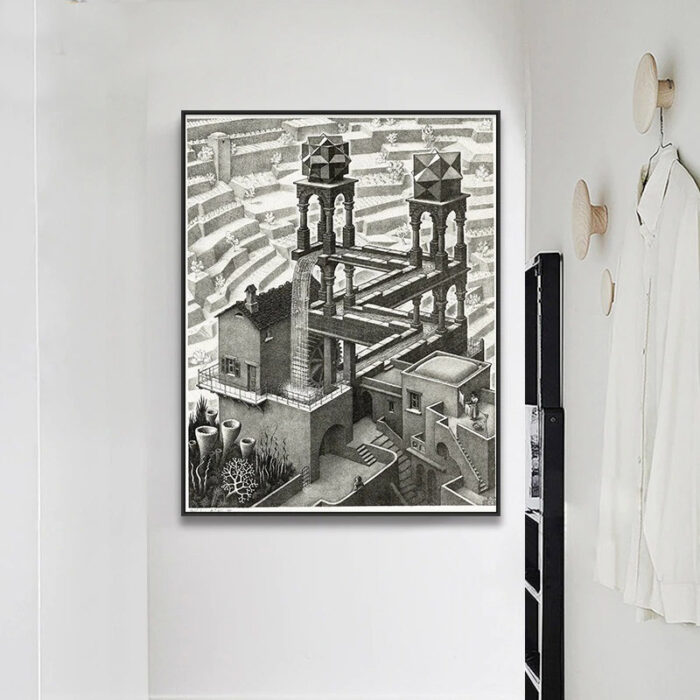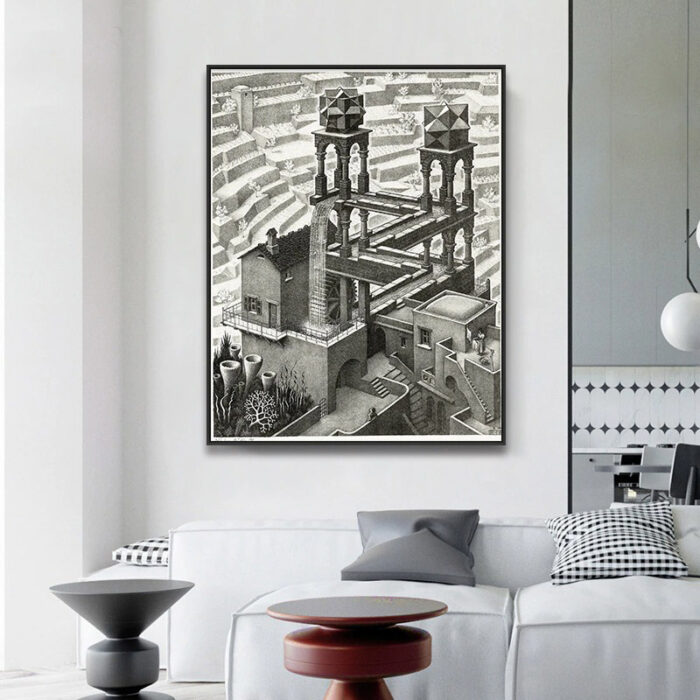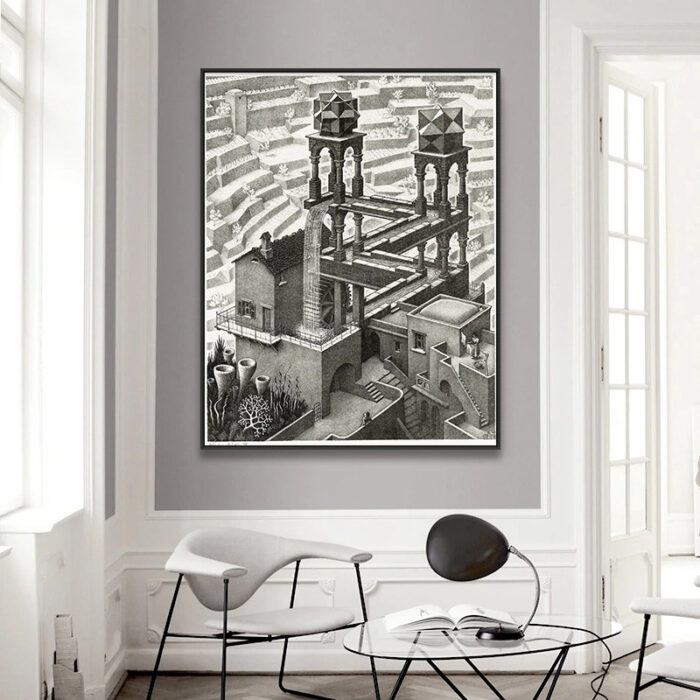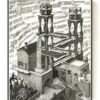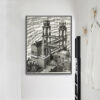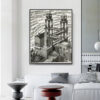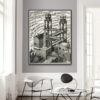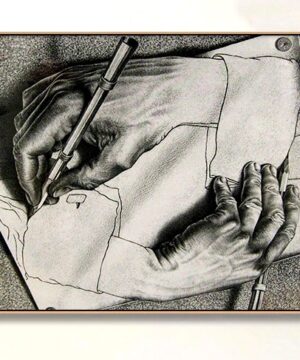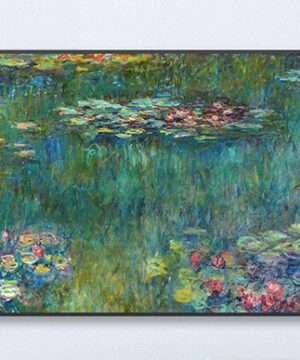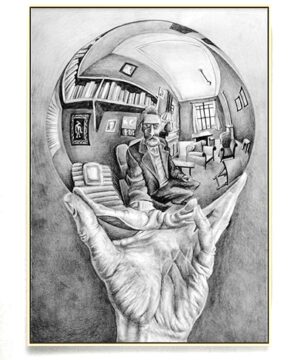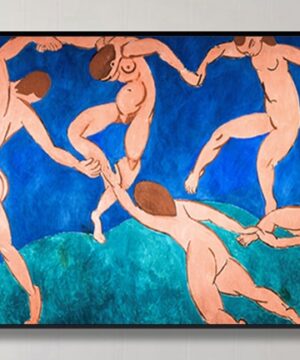Dutch artist Maurits Cornelis EscherDutch artist Maurits Cornelis Escher (1898-1972) is internationally appreciated for his graphic art today. He is best known for his woodcuts, mezzotints, and lithographs, featuring mathematical and “impossible” objects, in which he explored symmetry, perspective, infinity, and reflection. Born as the youngest son of a civil engineer, he was a sickly child and had poor grades at school failing second More is best known for his woodcuts, mezzotints, and lithographs, featuring mathematical and “impossible” objects in which he explored symmetry, perspective, infinity, and reflection. In his artwork “Waterfall”, he uses conflicting proportions to create a visual paradox, experimenting with an imagined sphere, in which the laws of physics do not apply.
Where is the picture “Waterfall” today?
The original print of the lithograph “Waterfall” is part of a private collection today.
What’s in it?
Set in a small village, the focus of the image lays on an elevated aqueduct with a waterwheel in an architecture in tonesIn color theory, a tone is a version of a color created by adding gray (a mix of black and white) to the original hue. This concept is essential for artists and designers as it allows for a wide range of colors that are neither too dark nor too light, providing versatility in creating depth, mood, and harmony within a More of black, white, and gray, apparently in a three-dimensional structure. At first glance, the viewer sees water cascading down from a raised platform. A closer look reveals that the building does not adhere to common rules of gravity since the water would have to be flowing upwards according to the architectural structure while the walls of the aqueduct step downward. Water falls off the edge of the aqueduct flowing over the waterwheel which would lead into an impossible infinite cycle.
Two towers support the aqueduct and are topped by complex geometrical shapes known as compound polyhedral. While the right one is a stellation of a rhombic dodecahedron, the one on the left shows a compound of three cubes.
A garden of bizarre plants surrounds the watermill, more reminiscent of a coral reef than garden plants. They are recognizable as being a cluster of moss and lichen which Escher explored in drawings of 1942. Terraced farmland stretches out in the immediate vicinity of the background.
What’s the context?
Escher used the phenomenon of the Penrose triangle – a two-dimensional depiction of a shape in which surfaces seem to ascend and descend at the same time, forming a continuous loop. It creates an optical illusion consisting of an object that is depictable in a perspective drawingDrawing is a foundational art form that involves creating images on a surface, typically paper, using tools such as pencils, pens, and charcoal. It is a versatile medium that allows artists to express ideas, emotions, and stories through lines, shapes, and shading. Historical Background • Prehistoric Beginnings: The earliest known drawings date back to prehistoric times, with cave drawings found More, but which is impossible to exist as a solid object. It was first created by Swedish artist Oscar Reutersvärd in 1934 and later devised and popularized in the 1950s by psychiatrist Lionel Penrose and his son, prominent Nobel Prize-winning mathematician Sir Roger Penrose.
In “Waterfall”, the watercourse meanders along the long sides of two elongated Penrose triangles, but ending up two stories higher than it began. It is the waterfall, which is forming the short sides of both triangles, that drives a water wheel.
Regarding his lithograph, Escher noted in a letter:
“Waterfall, which is brand new, is based on an idea from the two Penroses. It is another of their exciting ‘impossible objects’, a copy of which is included below. Published in the British Journal of Psychology, February 1958. Title of the article: ‘Impossible objects: a special type of visual illusion’ by L.S. Penrose and R. Penrose. They mention my name in this article too.”
Chatter and Prattle
M. C. Escher – Facts:
- Contrary to popular belief, Escher had only little formal knowledge of mathematics. He was never an outstanding student, and his theoretical mathematical knowledge was restricted to what he had received at secondary school. He later tried to study architecture but decided to drop out to fully focus on his career as a graphic artist. Notwithstanding, mathematics and geometry became key elements of his artistic work.
- In the mid-1930s Escher’s interest in mathematics increased. While his early work is more intuitive, he took to much more complicated structures like the Penrose triangle after he cooperations with mathematicians.
- The artist was specifically interested in concepts such as the regular division of the plane, which he explored in depth in his lithographs, further worked with S. M. Coxeter on tessellationsDefinition and Overview A tessellation is a pattern of shapes that fit perfectly together without any gaps or overlaps. These patterns can extend infinitely in any direction on a flat plane. Tessellations are often seen in art, architecture, and nature, and they play a significant role in the field of mathematics, particularly in geometry. Types of Tessellations There are three More and formed a lasting collaboration with Roger Penrose exploring mathematically impossible forms.
Do you want to comment on this text or add information? We would like to hear from you.
Read our posts on Escher:
M.C. Escher Art Work: 19 Fascinating Insights into His Life and Creations
M.C. Escher-Like Pop Culture: Homages to the Master of Illusions
Escher’s Printmaking Secrets: Perfect Your Projects with the Best Lino Print Kit
Recommended Reading:
M. C. Escher (2000): M.C. Escher: The Graphic Work Introduced and Explained By the Artist
Bruno Ernst (1997): The Magic Mirror of M.C. Escher (Taschen Specials) by Bruno Ernst (1997-07-31)
F. H. Bool et al. (1992): M.C. Escher: His Life and Complete Graphic Work (With a Fully Illustrated Catalogue)
J. L. Locher (2013): The Magic of M.C. Escher
This article may contain compensated links. Please read Disclaimer for more info. As an Amazon Associate, I earn from qualifying purchases.


